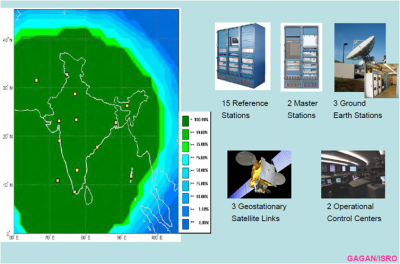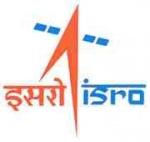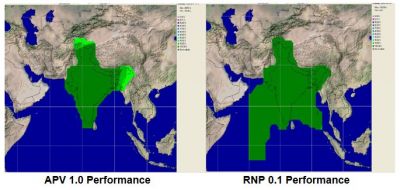If you wish to contribute or participate in the discussions about articles you are invited to contact the Editor
GAGAN: Difference between revisions
Paulo.Pombal (talk | contribs) |
Gema.Cueto (talk | contribs) (Fixed wikipedia reference) |
||
| (18 intermediate revisions by 2 users not shown) | |||
| Line 12: | Line 12: | ||
[[File:Isrologo.jpg|ISRO logo|150px|thumb]] | [[File:Isrologo.jpg|ISRO logo|150px|thumb]] | ||
In August 2001 the | In August 2001 the Airports Authority of India and the Indian Space Research Organization (ISRO) reached an agreement for the establishment of the GAGAN system.<ref>Grewal et al., ''Global positioning systems, inertial navigation, and integration'', Wiley-Interscience, 2007</ref> | ||
The development plan consists of two different phases:<ref name="GAGAN_ICG8">[http://unoosa.org/pdf/icg/2013/icg-8/5.pdf ''IRNSS and GAGAN status Presentation''] S. Sayeenathan, ICG-8, DUBAI, November 2013</ref> | The development plan consists of two different phases:<ref name="GAGAN_ICG8">[http://unoosa.org/pdf/icg/2013/icg-8/5.pdf ''IRNSS and GAGAN status Presentation''] S. Sayeenathan, ICG-8, DUBAI, November 2013</ref> | ||
#Technology Demonstration System (TDS) | #Technology Demonstration System (TDS) with the Initial Experimental Phase (IEP); | ||
#Final Operational phase (FOP). | #Final Operational phase (FOP). | ||
The TDS phase was completed in August 2007 using the navigation payload of the INMARSAT 4F1 satellite. The | The TDS phase was completed in August 2007 using the navigation payload of the INMARSAT 4F1 satellite. The IEP was conducted at the same time, concluding in 2009 <ref name="GAGAN RSA">[https://www.icao.int/APAC/APAC-RSO/GBASSBAS%20Implementation%20Workshop/3-7_GAGAN_Regional_Service_Availability%20(T%20Schemmp).pdf GAGAN Regional Service Availability]</ref>. | ||
On 15 April 2010, | On 15 April 2010, an attempt to launch the first GAGAN navigation payload took place. The equipment was installed in the satellite, GSAT-4, but, unfortunately, the launch failed and the GEO satellite never reached its nominal orbit<ref>[http://www.thehindu.com/news/article398070.ece ''India’s own cryogenic rocket launch fails'']The Hindu news, 15th April 2010</ref>. In May 2011, the GSAT-8 satellite carrying a GAGAN SBAS payload was successfully launched by the Ariane-V launch vehicle of Arianespace from Kourou, French Guiana<ref>[https://www.geospatialworld.net/news/indias-gsat-8-satellite-to-help-gagan/ India’s GSAT-8 satellite to help GAGAN, Geospatial World, May 2011]</ref>. Later on 28 September 2012, another Ariane 5 rocket successfully launched the India's GSAT-10 satellite which carries the second GAGAN payload <ref>[https://www.gpsworld.com/gsat-10-gagan-satellite-launched/ GSAT-10 GAGAN Satellite Launched, GPSWorld, October 2012]</ref>. | ||
GAGAN Stability tests were successfully completed in June 2013. The overall performance of the systems was reviewed by the review committee of the DGCA (Director General of Civil Aviation)<ref>[http://www.isro.gov.in/applications/satellite-navigation-programme GPS Aided Geo Augmented Navigation (GAGAN)]</ref>. | GAGAN Stability tests were successfully completed in June 2013. The overall performance of the systems was reviewed by the review committee of the DGCA (Director General of Civil Aviation)<ref>[http://www.isro.gov.in/applications/satellite-navigation-programme GPS Aided Geo Augmented Navigation (GAGAN) in ISRO website]</ref>. In December 2013, the system was certified for RNP 0.1 and started APV1 operations. The Final Operational Phase (FOP) was completed in 2014.<ref name="DGCA">[http://gagan.aai.aero/gagan/content/dgca-certification DGCA certification]</ref><ref>[https://www.icao.int/APAC/APAC-RSO/GBASSBAS%20Implementation%20Workshop/1-7_System%20Development-GAGAN_final%20(M%20Rao).pdf System Development - GAGAN: GBAS/SBAS Implementation Workshop, Seoul, June 2019]</ref> | ||
On 21 April 2015 it was certified for approach with vertical guidance (APV1) becoming the third SBAS in the world to achieve it and the first to do so operating in the equatorial region.<ref>[https://www.icao.int/APAC/APAC-RSO/GBASSBAS%20Implementation%20Workshop/3-7_GAGAN_Regional_Service_Availability%20(T%20Schemmp).pdf GAGAN Regional Service Availability]</ref><ref name="DGCA"/> | |||
The third and last satellite (GSAT-15) was launched onboard an Ariane 5 rocket on 10 November 2015.<ref name="Ariane5">[https://www.isro.gov.in/indias-gsat-15-communication-satellite-launched-successfully India's GSAT-15 Communication Satellite Launched Successfully]</ref> | |||
==GAGAN Architecture== | ==GAGAN Architecture== | ||
[[File:gagan_overview.png|GAGAN overview.<ref name="GAGAN WIKI">[https://en.wikipedia.org/wiki/GPS-aided_GEO_augmented_navigation GPS Aided Geo Augmented Navigation on Wikipedia]</ref>|400px|thumb]] | |||
The main components of the GAGAN Architecture are:<ref name="GAGAN_ICG8"/> | |||
*'''Space segment''': three operational GEO satellites<ref name="currProg"> Navigation Current Programme, Indian Space Research Organization</ref><ref name=" futProg">Forth Future Programme, Indian Space Research Organization</ref><ref name="Ariane5"/>: | |||
**GSAT-8: Launched in March 2011. | |||
**GSAT-10: Launched in April 2012. | |||
**GSAT-15: Launched in November 2015. | |||
* | *'''Ground segment''': On the ground, the GPS data is received and processed in the 15 (of the up to 45 it can support <ref name="GAGAN FAQ">[http://gagan.aai.aero/gagan/content/faq-0 GAGAN FAQ]</ref>) Indian Reference Stations (INRES), located at Ahmedabad, Bangalore, Bhubaneswar, Kolkata, Delhi, Dibrugarh, Gaya, Goa, Guwahati, Jaisalmer, Jammu, Nagpur, Porbandar, Port Blair, Trivandrum. The Indian Master Control Center (INMCC) composed by two operational sites located in Bangalore and Delhi, processes the data from the INRESs to compute the differential corrections and the estimate of its level of integrity. The SBAS message generated by the two INMCC is uplinked to the GEO satellites through its corresponding Indian Land Uplink Station (INLUS)<ref name="GAGAN_RESULTS">[http://www.icao.int/APAC/Meetings/2012_ISTF_1/IP02_India%20AI.4%20-%20Presentation.ppt C.L.Indi (GAGAN), Surendra Sunda (GAGAN), Airports Authority of India, "GAGAN - Ionospheric data collection and analysis over Indian region - Recent results", First Meeting of ionospheric Studies Task Force (ISTF/1) 27th -29th Feb 2012]</ref><ref name="GAGAN RSA"/>. | ||
*'''User segment''': GAGAN-enabled GPS receivers, with the same technology as [[WAAS Receivers]], capable to use the GAGAN Signal-in-Space (SIS). User equipment for civil aviation shall be certified against several standards (see article [[SBAS Standards]]). | |||
*User segment: GAGAN-enabled GPS receivers, with the same technology as [[WAAS Receivers]], capable to use the GAGAN Signal-in-Space (SIS). User equipment for civil aviation shall be certified against several standards (see article [[SBAS Standards]]). | |||
The company Raytheon was awarded in 2009 with the contract to modernize the Indian air navigation system. | The company Raytheon was awarded in 2009 with the contract to modernize the Indian air navigation system. Raytheon was responsible for building the Ground Stations being supplied by some ground equipment by ISRO.<ref>[https://insidegnss.com/isro-extends-raytheon-contract-for-gagan-gps-augmentation-system/ ''ISRO Extends Raytheon Contract for GAGAN GPS Augmentation System''] Inside GNSS News July 2009</ref> | ||
==GAGAN Signals and Performances== | ==GAGAN Signals and Performances== | ||
[[File:GAGANperformance.jpg|GAGAN performance<ref name="GAGAN FAQ"/>. Real time monitoring can be accessed [http://gagan.aai.aero/gagan/content/apv-1-rnp-01-services here].|400px|thumb]] | |||
The GAGAN GEO satellites | The GAGAN GEO satellites broadcast SBAS navigation data using L1 and L5 signals (this latter still under development), with Global Positioning System (GPS) type modulation<ref name="GAGAN WIKI"/>. | ||
The specification of the SBAS message data format is contained in the [http://www.icao.org ICAO] SARPS Appendix B for the aspects related with the signal in space, as well as in the RTCA MOPS DO- | The specification of the SBAS message data format is contained in the [http://www.icao.org ICAO] SARPS Appendix B for the aspects related with the signal in space, as well as in the RTCA MOPS DO-229 for the minimum performance requirements applicable to the airborne SBAS receiver equipment. The format of the messages is thoroughly explained in the article [[The EGNOS SBAS Message Format Explained]]. (See the article [[SBAS Fundamentals]] for more information.) | ||
GAGAN is designed to achieve a [[SBAS Fundamentals|performance]] level of<ref name="GAGAN FAQ"/>: | |||
*RNP 0.1 | *APV 1.0 over the Indian land mass. | ||
*RNP 0.1 over the oceanic region, within the Indian Flight Information Region (FIR). | |||
On December 30, 2013 the GAGAN system was certified to RNP0.1 service level by the Director General of Civil Aviation (DGCA). This means, as of this date, | On December 30, 2013 the GAGAN system was certified to RNP0.1 service level by the Director General of Civil Aviation (DGCA) and on 21 April 2015 it was certified for approach with vertical guidance (APV1) (both have been renewed for up to 18 July 2022) <ref name="DGCA"/>. This means, as of this date, aircraft equipped with SBAS receivers will be able to use GAGAN SiS in Indian airspace for en route navigation and approach operations with vertical guidance. The GAGAN signal availability filled the gap between [[EGNOS General Introduction|EGNOS]] and [[MSAS General Introduction|MSAS]] coverage areas.<ref>[http://gpsworld.com/gagan-certified-for-aviation-in-india/ GAGAN Certified for Aviation in India], GPS World, GPS Staff, January 13, 2014</ref><ref>[http://www.insidegnss.com India Certifies GAGAN for En Route and NPA Flight Operations], Inside GNSS, January 14, 2014</ref><ref name="GAGAN FAQ"/> | ||
==Ionospheric issues== | ==Ionospheric issues== | ||
Latest revision as of 10:47, 22 June 2021
| Other SBAS | |
|---|---|
| Title | GAGAN |
| Edited by | GMV |
| Level | Basic |
| Year of Publication | 2011 |
The GPS Aided Geo Augmented Navigation system (GAGAN) is the SBAS implementation by the Indian government.
GAGAN Introduction
In August 2001 the Airports Authority of India and the Indian Space Research Organization (ISRO) reached an agreement for the establishment of the GAGAN system.[1]
The development plan consists of two different phases:[2]
- Technology Demonstration System (TDS) with the Initial Experimental Phase (IEP);
- Final Operational phase (FOP).
The TDS phase was completed in August 2007 using the navigation payload of the INMARSAT 4F1 satellite. The IEP was conducted at the same time, concluding in 2009 [3].
On 15 April 2010, an attempt to launch the first GAGAN navigation payload took place. The equipment was installed in the satellite, GSAT-4, but, unfortunately, the launch failed and the GEO satellite never reached its nominal orbit[4]. In May 2011, the GSAT-8 satellite carrying a GAGAN SBAS payload was successfully launched by the Ariane-V launch vehicle of Arianespace from Kourou, French Guiana[5]. Later on 28 September 2012, another Ariane 5 rocket successfully launched the India's GSAT-10 satellite which carries the second GAGAN payload [6].
GAGAN Stability tests were successfully completed in June 2013. The overall performance of the systems was reviewed by the review committee of the DGCA (Director General of Civil Aviation)[7]. In December 2013, the system was certified for RNP 0.1 and started APV1 operations. The Final Operational Phase (FOP) was completed in 2014.[8][9]
On 21 April 2015 it was certified for approach with vertical guidance (APV1) becoming the third SBAS in the world to achieve it and the first to do so operating in the equatorial region.[10][8]
The third and last satellite (GSAT-15) was launched onboard an Ariane 5 rocket on 10 November 2015.[11]
GAGAN Architecture

The main components of the GAGAN Architecture are:[2]
- Space segment: three operational GEO satellites[13][14][11]:
- GSAT-8: Launched in March 2011.
- GSAT-10: Launched in April 2012.
- GSAT-15: Launched in November 2015.
- Ground segment: On the ground, the GPS data is received and processed in the 15 (of the up to 45 it can support [15]) Indian Reference Stations (INRES), located at Ahmedabad, Bangalore, Bhubaneswar, Kolkata, Delhi, Dibrugarh, Gaya, Goa, Guwahati, Jaisalmer, Jammu, Nagpur, Porbandar, Port Blair, Trivandrum. The Indian Master Control Center (INMCC) composed by two operational sites located in Bangalore and Delhi, processes the data from the INRESs to compute the differential corrections and the estimate of its level of integrity. The SBAS message generated by the two INMCC is uplinked to the GEO satellites through its corresponding Indian Land Uplink Station (INLUS)[16][3].
- User segment: GAGAN-enabled GPS receivers, with the same technology as WAAS Receivers, capable to use the GAGAN Signal-in-Space (SIS). User equipment for civil aviation shall be certified against several standards (see article SBAS Standards).
The company Raytheon was awarded in 2009 with the contract to modernize the Indian air navigation system. Raytheon was responsible for building the Ground Stations being supplied by some ground equipment by ISRO.[17]
GAGAN Signals and Performances
The GAGAN GEO satellites broadcast SBAS navigation data using L1 and L5 signals (this latter still under development), with Global Positioning System (GPS) type modulation[12]. The specification of the SBAS message data format is contained in the ICAO SARPS Appendix B for the aspects related with the signal in space, as well as in the RTCA MOPS DO-229 for the minimum performance requirements applicable to the airborne SBAS receiver equipment. The format of the messages is thoroughly explained in the article The EGNOS SBAS Message Format Explained. (See the article SBAS Fundamentals for more information.)
GAGAN is designed to achieve a performance level of[15]:
- APV 1.0 over the Indian land mass.
- RNP 0.1 over the oceanic region, within the Indian Flight Information Region (FIR).
On December 30, 2013 the GAGAN system was certified to RNP0.1 service level by the Director General of Civil Aviation (DGCA) and on 21 April 2015 it was certified for approach with vertical guidance (APV1) (both have been renewed for up to 18 July 2022) [8]. This means, as of this date, aircraft equipped with SBAS receivers will be able to use GAGAN SiS in Indian airspace for en route navigation and approach operations with vertical guidance. The GAGAN signal availability filled the gap between EGNOS and MSAS coverage areas.[18][19][15]
Ionospheric issues
One of the main concerns about an SBAS implementation in India is the ionospheric behavior at these latitudes, as India is located in the equatorial ionospheric anomaly belt. The ionosphere near the geomagnetic equator has physical process and features that rarely affect mid-latitudes. These include the Appleton geomagnetic anomaly, plasma bubbles, and scintillations.
Free from adverse ionospheric effects, current SBAS in the mid magnetic latitudes provide vertical guidance for the single frequency users. The ionosphere equatorial anomaly and the ionospheric phenomena typically found at equatorial latitudes, produce large spatial gradients and temporal gradients in the ionospheric delay. This significantly challenges SBAS to meet the stringent requirements associated to precision guidance. The macroscopic effects (equatorial anomaly) are not well approximated with the 5 x 5 degree grid thin shell model specified in the current SBAS Standards. Also, the microscopic phenomena (plasma bubbles) cause sharp gradients during a short period of time (less than 5 minutes). If these small scale features are not observed or alerted by the SBAS system, it would make difficult to ensure integrity compatible with the precision approach alert limits. Finally, the user equipment and the reference stations of the SBAS system might suffer from tracking and noise problems because of scintillation, which is a particularly likely problem in equatorial latitudes depending on the season and day time. All these problems are under study by several groups and different approaches for an SBAS implementation in equatorial magnetic regions have been presented.[20][21][22][23][24]
In order to cope with the ionospheric perturbations at the equatorial level, the GAGAN system makes use of the ISRO GIVE Model – Multi Layer Data Fusion (IGM-MLDF). The model ensures that the broadcast GIVEs have a sufficiently high level of integrity so that the user ionosphere vertical errors (UIVEs) computed by user receivers will bound their vertical ionosphere errors with a very high probability. The algorithm provides the delay and the confidence values for the user, resulting in improved accuracy and availability. [25]
References
- ^ Grewal et al., Global positioning systems, inertial navigation, and integration, Wiley-Interscience, 2007
- ^ a b IRNSS and GAGAN status Presentation S. Sayeenathan, ICG-8, DUBAI, November 2013
- ^ a b GAGAN Regional Service Availability
- ^ India’s own cryogenic rocket launch failsThe Hindu news, 15th April 2010
- ^ India’s GSAT-8 satellite to help GAGAN, Geospatial World, May 2011
- ^ GSAT-10 GAGAN Satellite Launched, GPSWorld, October 2012
- ^ GPS Aided Geo Augmented Navigation (GAGAN) in ISRO website
- ^ a b c DGCA certification
- ^ System Development - GAGAN: GBAS/SBAS Implementation Workshop, Seoul, June 2019
- ^ GAGAN Regional Service Availability
- ^ a b India's GSAT-15 Communication Satellite Launched Successfully
- ^ a b GPS Aided Geo Augmented Navigation on Wikipedia
- ^ Navigation Current Programme, Indian Space Research Organization
- ^ Forth Future Programme, Indian Space Research Organization
- ^ a b c d GAGAN FAQ
- ^ C.L.Indi (GAGAN), Surendra Sunda (GAGAN), Airports Authority of India, "GAGAN - Ionospheric data collection and analysis over Indian region - Recent results", First Meeting of ionospheric Studies Task Force (ISTF/1) 27th -29th Feb 2012
- ^ ISRO Extends Raytheon Contract for GAGAN GPS Augmentation System Inside GNSS News July 2009
- ^ GAGAN Certified for Aviation in India, GPS World, GPS Staff, January 13, 2014
- ^ India Certifies GAGAN for En Route and NPA Flight Operations, Inside GNSS, January 14, 2014
- ^ Doherty, Patricia et al., "Ionospheric Effects on Low-Latitude Space Based Augmentation Systems", proceedings of ION GPS, Portland, OR, September 2002.
- ^ Lejeune, R. et al., "Adequacy of the SBAS Ionospheric Grid Concept for Precision Approach in the Equatorial Region", proceedings of ION GPS, Portland, OR, September 2002.
- ^ Wu, S. et al., "A Single Frequency Approach to Mitigation of Ionospheric Depletion Events for SBAS in Equatorial Regions", ION GNSS 2006.
- ^ Cormier, D., et al., "Providing Precision Approach SBAS Service and Integrity in Equatorial Regions," Proceedings ION GPS/GNSS 2003, Portland, OR, September 2003.
- ^ Shukla, A.K., et al,‘’Two-Shell Ionospheric Model for Indian Region: A Novel Approach’’ IEEE Transactions on Geoscience and Remote Sensing, Aug. 2009 Volume: 47 Issue:8,Pages 2407 – 2412
- ^ GAGAN — India’s SBAS


